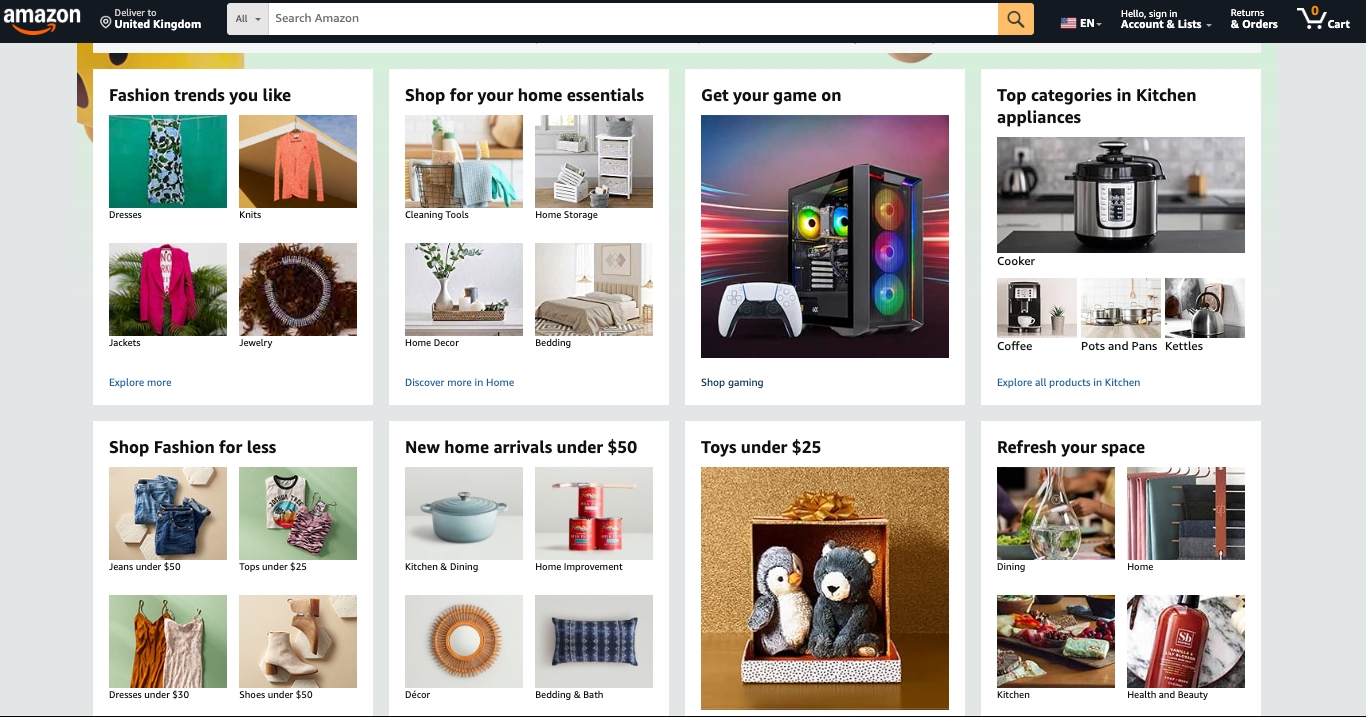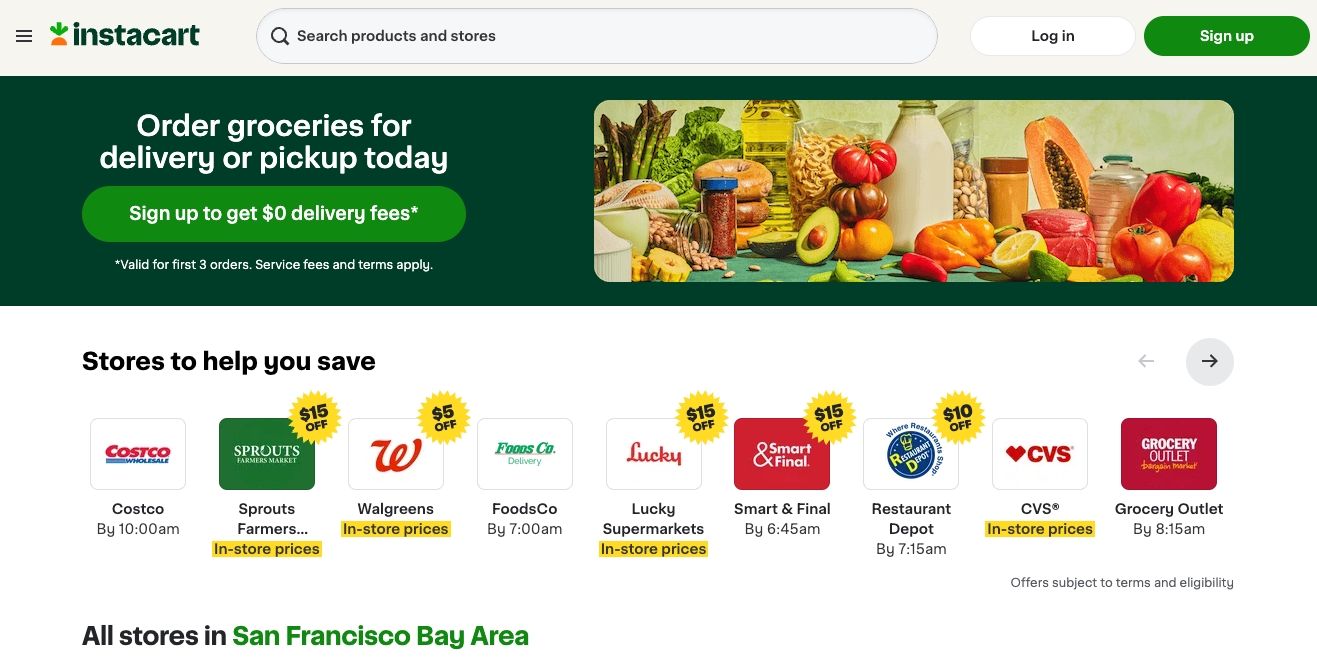B2B2C ecommerce, or business-to-business-to-consumer ecommerce, is a model where businesses sell products to end consumers through intermediary companies, like Amazon, Booking.com, or Uber Eats. You know, the marketplaces.
This approach combines elements of both B2B and B2C models, allowing businesses to expand their reach without the need for direct consumer interaction.
In this article, we will explore what B2B2C ecommerce is, how it operates, and the advantages it brings to businesses.
Key takeaways
- The B2B2C model allows businesses to connect with consumers indirectly through intermediaries, enhancing market reach and operational efficiency.
- Key benefits of B2B2C ecommerce include improved market access, cost efficiency through outsourcing, and the potential for increased revenue streams.
- Challenges in B2B2C include high commissions from intermediaries, maintaining brand consistency, and ensuring a positive customer experience throughout all channels.
What is B2B2C ecommerce?

The B2B2C ecommerce model is a strategic approach where businesses collaborate with intermediary companies to sell products and services to end consumers. This model integrates the strengths of both B2B (business-to-business) and B2C (business-to-consumer) processes, creating a seamless flow from suppliers to the final consumer.
At its core, B2B2C involves 3 primary parties:
- Suppliers, who concentrate on production (e.g. a fashion brand producing clothes directly)
- Intermediaries, who manage marketing, sales, and customer interactions (e.g. Amazon that handles product listings, customer service, order fulfillment, and marketing for partner brands)
- Consumers, who are the end customers that receive the products
This model ensures that products are accessible to consumers while allowing suppliers to focus on their core competencies.
Industries such as ecommerce, food and beverage, and retail have seen significant benefits from adopting a business model that incorporates B2B2C strategies.
How B2B2C ecommerce works
B2B2C ecommerce works through a collaborative network where suppliers, intermediaries, and consumers interact to facilitate transactions. This model leverages the strengths of each party involved, from manufacturing and logistics to customer service and delivery. The process can be broken down into 2 main stages: supplier to intermediary and intermediary to consumer.
Supplier to intermediary
In this first step, the supplier partners with an intermediary to gain access to a wider market without directly managing end-user relationships.
The supplier provides:
- Products or services
- Inventory or catalog data
- Fulfillment support or integrations
The intermediary handles:
- Listing and promoting the supplier’s offerings
- Managing transactions and customer interfaces
- Logistics and/or customer support (in many cases, but not all)
For example:
A local organic food brand partners with Instacart. The brand provides products and inventory updates, while Instacart handles listings, consumer access, online orders, and delivery logistics, allowing the food brand to focus on their product instead of marketing and distribution.
Intermediary to consumer
The intermediary’s role in the B2B2C model is crucial, as they bridge the gap between suppliers and consumers. In this stage, the intermediary interfaces directly with the end consumer, completing the sales and service cycle.
The intermediary ensures:
- A seamless shopping experience (website, app, support)
- Order fulfillment or coordination with the supplier
- Payment processing and delivery updates
The consumer focuses on:
- Interacting primarily with the intermediary
- Recognizing (or not) the original supplier brand, depending on branding policies
- Receiving the product or service purchased via the intermediary platform
Example:
A consumer orders a set of kitchen appliances on Amazon. Though the items come from a third-party manufacturer, Amazon provides the purchase interface, handles delivery, and manages customer service if any issues arise.
Naturally, this approach has some clear pros and cons that every business needs to keep in mind before opting in for selling via a business-to-business-to-consumer model.
Benefits of B2B2C

The B2B2C model offers numerous advantages that can significantly boost a business’s performance. Here are some of the primary benefits:
- Enhanced market reach: Access large, established customer bases through intermediaries like marketplaces or apps, accelerating exposure without heavy marketing spend.
- The ability to introduce products to new customers: Leverage platform discovery tools and curated placements to get your products in front of untapped or unaware audiences.
- Generation of additional revenue streams: Diversify income by selling through multiple B2B2C channels alongside your direct sales, maximizing product ROI across markets.
This approach allows companies to expand their market presence effectively. The B2B2C model enables businesses to scale quickly and efficiently, making it an attractive option for companies looking to expand their reach and improve their bottom line.
Expanded market reach
B2B2C partnerships enable businesses to reach a wider consumer base by utilizing established platforms and marketplaces. Companies leveraging Amazon’s marketplace, for example, gain access to a broad audience with ease, as businesses partner with these platforms effectively.
These partnerships not only enhance market coverage but also drive faster growth by leveraging existing customer bases and marketing investments.
Cost efficiency
Another key benefit is cost efficiency. Outsourcing logistics and marketing to intermediaries helps businesses cut operational costs. This collaborative nature maximizes each party’s strengths, driving innovation and growth while minimizing overhead expenses.
The B2B2C model helps businesses achieve cost efficiency by outsourcing key services to partners. Selling via a marketplace, for example, negates the need for an independent online store, cutting initial investments and operational costs. Automation and technology integration further streamline operations, allowing businesses to optimize inventory management and reduce labor costs.
Challenges in B2B2C ecommerce

Despite its benefits, the B2B2C model presents several challenges for businesses. High commissions charged by intermediary platforms can impact profitability, making it essential for companies to carefully evaluate the worth of their collaborations. Additionally, maintaining consistent service quality becomes challenging as the customer base expands, necessitating robust customer service strategies.
High commissions
High commissions charged by intermediary platforms can significantly impact a business’s profitability in the B2B2C model. Amazon vendors, for example, often incur a fee per item sold plus a transaction commission. Businesses must assess the value of these collaborations and focus on maximizing sales to counterbalance the effects of high commissions.
Maintaining service quality
As the customer base grows, maintaining consistent service quality is crucial. Businesses need to implement robust customer service strategies to ensure customer satisfaction and loyalty.
Brand differentiation
Maintaining a consistent brand image across different partners is a significant challenge in the B2B2C model. Ensuring that the brand experience remains uniform is vital for converting sales and gaining brand recognition and a competitive edge. Companies should closely examine potential business partners and company partners to avoid any negative impact on brand credibility and ensure successful partnerships.
Successful B2B2C examples
[visual: examples of B2B2C commerce]
Real-world examples of successful B2B2C models demonstrate the potential of this business approach. Major marketplaces, booking and delivery apps, and small businesses associated with them have all leveraged B2B2C partnerships to thrive. Well-known platforms like Amazon, Alibaba, and eBay operate using B2B2C partnerships, allowing manufacturers to reach consumers directly through their platforms.
Amazon marketplace

Amazon Marketplace stands as the world’s largest ecommerce retailer, connecting millions of consumers with a vast array of products. Manufacturers can list their products on Amazon, gaining direct access to a global audience through a well-established platform. This approach enables third-party sellers to effectively enhance their market presence and boost sales.
In this setup:
- Manufacturers (Suppliers) list their products on Amazon.
- Amazon (Intermediary) handles product discovery, customer service, payment processing, and shipping (if using FBA – Fulfillment by Amazon).
- Consumers purchase directly through Amazon’s platform, often without interacting with the brand itself.
Benefits for manufacturers with Amazon:
- Massive reach: They're able to instantly access millions of global customers through Amazon’s trusted platform.
- Speed to market: There's no need to build or manage your own ecommerce site.
- Operational efficiency: Offload logistics, returns, and payments to Amazon (via FBA).
- Data insights: Amazon allows them to gain access to real-time sales and performance data to optimize listings and inventory.
Consumers, in turn, get to enjoy convenience benefits, like same-day delivery and a variety of choice among competing brands. There is also a certain level of trust associated with Amazon's platform, achieved via peer reviews and common supplier verification.
Instacart and grocery stores

Instacart partners with grocery stores to provide their B2B2C services, allowing these stores to reach more consumers through online platforms. Instacart meets modern consumer demands for convenience and prompt delivery service with its grocery services.
- Grocery retailers (Suppliers) provide product inventory and pricing.
- Instacart (Intermediary) manages the consumer interface, handles order fulfillment, and facilitates delivery logistics.
- Consumers browse, purchase, and receive groceries via Instacart without interacting directly with the grocery chain’s own ecommerce infrastructure.
The main benefits here remain similar, in addition to the digital reach. Once locked to on-site sales via third-party partner stores and markets, thanks to Instacart, produce suppliers can now offer online shopping to the new mass of customers without the need for building a custom website.
Choosing the right B2B2C platform
Selecting the right B2B2C platform is crucial for the success of any business adopting this model. It allows companies to leverage established systems, avoiding the need to develop from scratch. Thoroughly vetting potential partners is essential to maintain brand integrity and ensure successful collaborations.
SaaS platforms like Magento or BigCommerce, in particular, offer a smoother learning curve, making them ideal for newcomers to ecommerce.
Collaborative marketing efforts are also vital in B2B2C, as both partners must actively promote each other’s products to enhance brand visibility and consumer engagement. This alignment fosters trust and engagement, driving the success of the B2B2C model.
Magento (Adobe Commerce)
Magento, now known as Adobe Commerce, is a robust platform suitable for tech-driven companies and enterprise businesses. It offers extensive customization, inventory management, omnichannel support, and integration with major platforms like Amazon, making it ideal for B2B2C operations.
Magento’s architecture provides significant flexibility in design and functionality, allowing businesses to scale and adapt quickly.
BigCommerce
BigCommerce is a versatile SaaS platform that caters to small businesses with ready-made features and cost-effective solutions. Its starting monthly cost of $29.99 makes it accessible for small businesses looking to leverage the B2B2C model.
BigCommerce provides seamless integration and scalability, enabling businesses to grow without extensive customization.
Alokai serves as a tech partner for both BigCommerce and Magento, providing tailored solutions that enhance the capabilities of these platforms. By integrating Alokai's innovative technologies, businesses can optimize their ecommerce operations, ensuring a seamless experience for both suppliers and end consumers.
Marketing strategies for business-to-business-to-consumer models
Effective marketing strategies are essential for the success of B2B2C ecommerce. Leveraging intermediaries for marketing can reduce the need for extensive advertising, allowing businesses to focus on their core competencies.
Collaborative promotions are a vital marketing strategy within the B2B2C model. Joint promotional campaigns can significantly increase consumer reach and sales for both participating companies in a B2B2C arrangement. By leveraging each partner’s strengths, these campaigns enhance brand visibility and consumer engagement, driving growth and success for both partners.
Direct access to customer data is another key marketing strategy. It allows businesses to tailor their marketing strategies effectively. Sharing consumer insights between partners enhances the ability to target and personalize marketing efforts, meeting consumer needs and preferences better.
Integrating technology for seamless operations
Integrating technology is crucial for maintaining seamless operations in the B2B2C model. Effective integration of systems enhances the speed and accuracy of operations, ensuring a consistent customer experience across all service providers.
Integrating ERP systems with B2B2C platforms is vital for ensuring real-time updates and improving operational efficiency. Suppliers provide real-time inventory information to intermediaries, allowing for accurate product listings on marketplace platforms. This facilitates seamless information flow, enhancing the performance of B2B2C operations and ensuring timely decision-making.
Online payment platforms are crucial for providing a secure and efficient transaction process between businesses and consumers. These platforms facilitate secure transactions, making it easier for consumers to make purchases and for businesses to manage payments effectively.
Measuring success
Measuring the success of B2B2C ecommerce initiatives involves evaluating key performance indicators (KPIs) and other metrics. Secure online payment systems are essential for building trust between businesses and consumers, playing a vital role in the success of B2B2C transactions.
Analyzing NPS provides insights into customer satisfaction levels, helping businesses enhance their service quality and meet customer expectations. Additionally, evaluating the effectiveness of sales channels is crucial for optimizing business performance. Platforms like Magento and BigCommerce allow businesses to expand their market reach while maintaining cost efficiency through streamlined operations.
Why large companies choose the B2B2C model over selling only through their own website
For large enterprises selling online, the natural instinct may be to focus exclusively on their own branded ecommerce site. After all, it offers full control over brand, customer experience, and data. However, many successful brands choose to complement or even prioritize a B2B2C model—partnering with intermediaries like Amazon, Instacart, or Booking.com to reach consumers. Here's why this strategy makes sense for companies aiming to scale efficiently and competitively.

Instant access to larger audiences
Building traffic to a standalone ecommerce site is time- and resource-intensive. Intermediary platforms, by contrast, offer access to millions of active, high-intent users. Instead of competing for attention, your products are placed where your customers already shop.
This accelerates time-to-market and increases discoverability, especially when entering new categories, launching seasonal products, or expanding into new geographies.
Trusted platforms enhance conversion
Even loyal customers often prefer the ease of purchasing through platforms they already use. Intermediaries offer frictionless checkout, saved payment methods, personalized recommendations, and customer protection policies—all of which contribute to faster purchasing decisions and higher conversion rates.
For brands, this means increased revenue potential without needing to replicate the full ecommerce experience on their own.
Operational efficiency and scalability
B2B2C platforms handle many of the operational burdens that come with direct selling: payment processing, fraud prevention, fulfillment logistics, returns, and customer service. These services free up internal resources and allow large companies to focus on product innovation, supply chain optimization, and strategic growth.
This is particularly valuable for companies managing multiple product lines, geographies, or fulfillment centers.
Revenue diversification and lower risk
Relying solely on your own website introduces single-channel risk. A B2B2C strategy allows companies to diversify revenue streams by selling across multiple platforms and partner ecosystems. If performance in one channel fluctuates, others can help maintain stability.
This diversified approach also protects against changes in ad costs, SEO performance, or platform policy shifts that could impact a single channel.
Access to marketing tools and customer insights
Most B2B2C platforms provide robust analytics dashboards, sponsored ad programs, and promotional tools. These insights allow companies to track performance in real time, adjust pricing and inventory dynamically, and run high-ROI marketing campaigns with precision.
While you may not own the customer relationship in the same way as on your DTC site, these platforms offer valuable behavioral data that can inform both B2B2C and DTC strategies.
The hybrid advantage
Ultimately, the most effective approach for large companies is not to choose between their website and a B2B2C model, but to embrace both. A hybrid strategy allows brands to maintain full control and deep engagement on their owned channels, while using intermediary platforms to boost reach, reduce overhead, and meet customers where they already shop.
By combining these models, businesses unlock greater agility, market penetration, and operational resilience—making B2B2C a strategic growth lever in modern commerce.
Learn how to unlock the model flexibility with the right tech stack: request an Alokai demo!


















